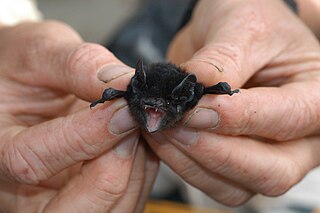
Vespertilionidae is a family of microbats, of the order Chiroptera, flying, insect-eating mammals variously described as the common, vesper, or simple nosed bats. The vespertilionid family is the most diverse and widely distributed of bat families, specialised in many forms to occupy a range of habitats and ecological circumstances, and it is frequently observed or the subject of research. The facial features of the species are often simple, as they mainly rely on vocally emitted echolocation. The tails of the species are enclosed by the lower flight membranes between the legs. Over 300 species are distributed all over the world, on every continent except Antarctica. It owes its name to the genus Vespertilio, which takes its name from a word for bat, vespertilio, derived from the Latin term vesper meaning 'evening'; they are termed "evening bats" and were once referred to as "evening birds".

The New Zealand long-tailed bat, also known as the long-tailed wattled bat or pekapeka-tou-roa (Māori), is one of 15 species of bats in the genus Chalinolobus variously known as "pied bats", "wattled bats" or "long-tailed bats". It is one of the two surviving bat species endemic to New Zealand, but is closely related to five other wattled or lobe-lipped bats in Australia and elsewhere. It was named the winner in the 2021 Bird of the Year competition in New Zealand, despite not being a bird.

Gould's wattled bat is a species of Australian wattled bat named after the English naturalist John Gould.

The large-eared pied bat is a species of vesper bat in the family Vespertilionidae.

The chocolate wattled bat, species Chalinolobus morio, is a bat allied to the family Vespertilionidae. It is found only in Australia, including the island Tasmania, and widespread in southern regions. It is known to reside from sea level to at least 1,570 metres (5,150 ft) in Victoria.
The New Caledonian wattled bat is a species of vesper bat, family Vespertilionidae. It is found only in New Caledonia.
The little pied bat is a species of vesper bat in the family Vespertilionidae. It is found only in semi-arid woodlands in eastern Australia.
The variegated butterfly bat is a species of vesper bat. It is sometimes also called the leaf-winged bat, or simply the butterfly bat. It is not currently endangered, but may be threatened by habitat loss in some parts of its range.

Nyctophilus arnhemensis, known as the northern or Arnhem long-eared bat, is a species of Chiroptera (bats) native to northern regions of Australia. The distribution range is from north-western Queensland to northern Western Australia.
The large forest bat is a vespertilionid bat found in southeast Australia, Tasmania, and Lord Howe Island. They are classified as common.
The southern forest bat is a vespertilionid bat found in Australia.

The demonic tube-nosed fruit bat is a species of bat in the family Pteropodidae. It is endemic to Papua New Guinea. The holotype specimen was collected in 1979 on New Ireland, in the Bismarck Archipelago. It was described as a new species in 1983. The range of the species may extend to other islands, however the extent of the range is not presently known.

Shamel's horseshoe bat is a species of bat in the family Rhinolophidae. It is found in Cambodia, Laos, Myanmar, Thailand and Vietnam.

Thomas's fruit-eating bat, sometimes also popularly called Watson's fruit-eating bat, is a species of bat in the family Phyllostomidae. It is found from southern Mexico, through Central America to Colombia. Its South American range is to the west of the Andes. The species name is in honor of H. J. Watson, a plantation owner in western Panama who used to send specimens to the British Natural History Museum, where Oldfield Thomas would often describe them.
The Cuban yellow bat is a species of bat from the family Vespertilioninae. It was previously included as a subspecies of the northern yellow bat, a species that has a similar ecology and biology. The species is endemic to Cuba, specifically the Las Villas Province in Cienfuegos, and it is listed under the IUCN Red List as vulnerable due to its ongoing population reduction and relatively small geographic range.










